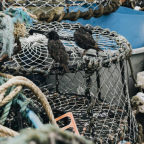
The government is under pressure to safeguard Britain’s marine conservation areas after analysis showed the Dogger Bank protected site has seen a threefold increase in destructive bottom trawling since Brexit. A year ago, conservationists welcomed government proposals to ban trawling and dredging fishing practices, which involve dragging weighted nets over the seabed, in 14,030 sq km (5,400 sq miles) of English waters, an area equivalent to the size of Northern Ireland. The area includes Dogger Bank and three other marine protected areas (MPAs).
The Marine Conservation Society (MCS) analysed fishing data tracked by Global Fishing Watch and found bottom trawling and dredging had increased at the site from about 1,700 hours a year between 2015 and 2018, to 5,500 hours a year between 2020 and the end of 2021.
t accused the government of “broken promises and delayed action” over the proposed fishing ban, which is not yet in place a year on. The ban was introduced via a bylaw, which is typically passed within 12 months.
In a statement, the Department for Environment, Food and Rural Affairs (Defra) said new bylaws to ban bottom trawling in the four MPAs were “being finalised”, but did not give a timescale.
The Dogger Bank MPA, one of the largest sandbanks in Europe, at 12,300 sq km, is a vital breeding ground for commercial species including cod and whiting, as well as sand eels, which are a food source for puffins, porpoises and kittiwakes. It is also an important site for blue carbon, the CO2 sequestered and stored in coastal and marine ecosystems.
Nearly a quarter of UK territorial waters are covered by MPAs, set up to protect vital ecosystems and species, including harbour porpoises and dolphins. This network is a symbol of the government’s target to protect 30% of ocean biodiversity by 2030.
However, more than 97% of British MPAs are being dredged and bottom trawled, according to data shared with the Guardian.
Dr Jean-Luc Solandt, principal specialist in MPAs at the MCS said: “MPAs are currently a lie. There has been an incredible increase in damaging fishing in the Dogger Bank since we left the EU. Are we really ‘taking back control’ of our waters?
“The government promised this a year ago. We were very optimistic but nothing has happened. There is no sign of the promised timetable to ensure management for England’s entire list of 40 offshore MPAs.”
At current rates, it would take more than a decade to get management in place for all MPAs, Solandt said.
Frith Dunkley, MPA researcher at MCS said: “In the year since this bylaw banning bottom-towed fishing gear from Dogger Bank MPA was proposed, the sandbank habitat and the species it was designated to protect have continued to be damaged by fishing activity, degrading marine life and removing ecologically important species such as sand eels.”
This week, the MCS is launching a social media campaign with the hashtag MarineUnprotectedAreas, calling for the public to tweet their MPs and MSPs to ban bottom trawling and dredging in offshore MPAs.
Ministers also face pressure to safeguard the seabed from within the Tory party. On Tuesday, the former transport secretary, Chris Grayling, will raise a 10-minute motion in parliament for a bill introducing a duty on the secretary of state to ban bottom trawling in MPAs.
Charles Clover, executive director of the Blue Marine Foundation, which will back the MCS campaign, said: “If we have learned anything in marine conservation it is this: meaningful protection allows for significant and swift regeneration. In order to protect our fish stocks and low-impact fisheries the UK must wake up and efficiently protect these ‘protected areas’, from the seabed up.”
The government has argued that, before Brexit, it did not have control over fishing rights.
When George Eustice, the environment secretary, announced proposals to ban bottom trawling in the four MPAs last year, he said: “Now that we have left the common fisheries policy, we are able to deliver on our commitment to achieve a healthy, thriving and sustainable marine environment.”
Citing the Fisheries Act’s power to further protect Britain’s seas, Eustice added: “This proposal to introduce bylaws to safeguard four of our precious offshore marine protected areas shows how we are putting these powers into action.”
Located about 75 miles east of Hull, the Dogger Bank has been heavily fished for decades. Bottom trawling releases carbon from the seabed into the ocean, reducing its ability to buffer climate breakdown. Dogger Bank has the capacity to store the most carbon out of all English MPAs, according to the MCS.
Last September, Greenpeace dropped giant boulders from its ship into the Dogger Bank MPA in order to create an exclusion zone for trawlers.
A Defra spokesperson said: “We are focused on ensuring all English MPAs are being effectively managed as quickly as possible – 98 in-shore MPAs now have management measures in place to protect sensitive features from bottom-towed fishing gears.
“Following our 2021 consultation, new bylaws protecting offshore MPAs are being finalised for the first four high-risk sites identified.”














Social Profiles